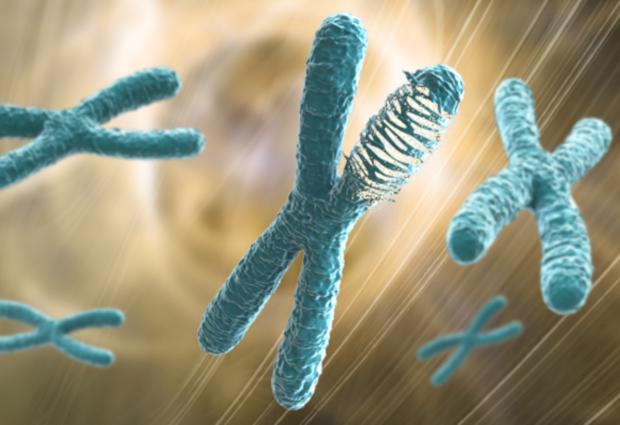Chromothripsis in human cancer

Artist's impression of chromothripsis. Credit: Spencer Phillips/EMBL-EBI Usage Restrictions: CC 3.0
Chromothripsis
Chromothripsis, or 'chromosome shattering', is a mutational process in which large stretches of a chromosome undergo massive rearrangements in a single catastrophic event. The chromosomal regions fragment into smaller pieces, rearrange, and rejoin, leading to a new genome configuration.
Fully understanding how these alterations drive cancer genome evolution, and what molecular mechanisms are involved in their generation, are important steps towards understanding cancer genome evolution.
This research was published in Nature Genetics as part of the Pan-Cancer Analysis of Whole Genomes (PCAWG) project, a global effort involving the international collaboration of over 1300 scientists. In this study, the researchers showed that chromothripsis events are much more common across many types of cancer than previously thought.
They could also directly link chromothripsis to common hallmarks of the cancer genome, including oncogene amplification (an increase in the number of copies of a gene that can cause cancer), and the loss of tumour suppressors (genes that regulate cell growth and division).
Chromothripsis prevalence in cancer
“We integrated WGS data from over 2600 tumours spanning more than 30 cancer types,” says Isidro Cortés-Ciriano, Group Leader at EMBL-EBI and a former postdoctoral researcher at Harvard Medical School.
“From this we discovered that chromothripsis events and other types of complex genome rearrangements are pervasive across human cancers, with frequencies greater than 50% of tumours in some cancer types.”
Using WGS datasets gave the researchers an enhanced view of chromothripsis events in the cancer genome. Previous studies looking at the role of chromothripsis in cancer and congenital diseases often used low-resolution array-based technologies.
Here the researchers were able to show that chromothripsis events are much more prevalent in cancer than previously estimated. They also characterised the patterns of massive genome alterations across cancer types, and studied the DNA repair mechanisms involved in their generation.
“This study is yet another demonstration of the power of large-scale whole-genome sequencing,” says Peter Park, Professor of Biomedical Informatics at Harvard Medical School and senior author of the paper. “It allowed us to probe the bewildering complexity of genome-shattering in cancer genomes and to characterise common features across hundreds of cases.”
Chromothripsis and cancer prognosis
“The discoveries made in this project allow us to better understand how cancer arises and evolves, as well as the patterns of alterations in the DNA of human tumours,” says Cortés-Ciriano. “Some of these alterations have strong clinical implications and could open new avenues for therapeutic development over the coming years.”
The researchers demonstrate that chromothripsis shapes the tumour genome, leading to the loss of tumour suppressor genes and amplification of oncogenes to drive cancer progression. Chromothripsis has been associated with poor prognosis for cancer patients, but continuing studies like this help us to understand the impact of chromothripsis and other large-scale genome alterations, and how they may be used for cancer diagnosis in the future.
The Pan-Cancer project
The Pan-Cancer Analysis of Whole Genomes project is a collaboration involving more than 1300 scientists and clinicians from 37 countries. It involved analysis of more than 2600 genomes of 38 different tumour types, creating a huge resource of primary cancer genomes. This was the starting point for 16 working groups to study multiple aspects of cancer development, causation, progression, and classification.
Media Contact
All latest news from the category: Life Sciences and Chemistry
Articles and reports from the Life Sciences and chemistry area deal with applied and basic research into modern biology, chemistry and human medicine.
Valuable information can be found on a range of life sciences fields including bacteriology, biochemistry, bionics, bioinformatics, biophysics, biotechnology, genetics, geobotany, human biology, marine biology, microbiology, molecular biology, cellular biology, zoology, bioinorganic chemistry, microchemistry and environmental chemistry.
Newest articles

Durable, Efficient, Sustainable: The Rise of Cerium Oxide Thermal Switches
Groundbreaking cerium oxide-based thermal switches achieve remarkable performance, transforming heat flow control with sustainable and efficient technology. Cerium Oxide-Based Thermal Switches Revolutionize Heat Flow Control Thermal switches, which electrically control…

How Industrial Robots are Reducing Emissions in Global Manufacturing
A new study explores the intersection of industrial automation and environmental sustainability, focusing on the role of industrial robots in reducing the carbon intensity of manufacturing exports. The research demonstrates…

Patients Can Heal Through Precise, Personalized Bioceramic Grafts
A recent review is transforming the landscape of craniomaxillofacial bone regeneration with the introduction of personalized bioceramic grafts. This pioneering research explores the fabrication and clinical potential of synthetic grafts…



